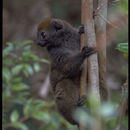Biology
provided by Arkive
As the common name suggests, bamboo lemurs specialise in feeding almost exclusively on bamboo (2) (6) (9), and are the only primates known to do so (5) (8). Bamboo constitutes at least 75 percent of the diet of the eastern lesser bamboo lemur, with the rest made up of fig leaves, grass stems, other young leaves, small fruits, flowers and fungi (3) (5) (9). Each species of bamboo lemur appears to specialise on different parts of the bamboo plant (2) (10), with the eastern lesser bamboo lemur preferring the new shoots, leaf bases and stem pith (2) (3) (5) (9). However, some bamboos contain toxic cyanide compounds that would poison most other mammals. How bamboo lemurs deal with these toxins is not exactly known, but the eastern lesser bamboo lemur may limit its intake by selecting young growth, which contains lower cyanide levels (8) (9). It also appears to have a more flexible diet than other bamboo lemurs, using different bamboo species or different food sources depending on the season (9) (11), which may help explain its wider geographic distribution (9).
Although often considered cathemeral, with regular bouts of activity both day and night (3) (5), others report the eastern lesser bamboo lemur to be mainly diurnal (11). Group size ranges from around two to nine, with each group typically containing an adult male, one or two breeding females, and offspring (3) (5) (8) (9). The adults are highly territorial, defending the group's territory with scent-marking, vocal displays and chases. Breeding occurs between October and January, the female usually giving birth to a single offspring each year, after a gestation period of 137 to 140 days. The infant may be carried in the female's mouth for the first few weeks, after which it may ride on the female's back, or be “parked” for short periods while the female is foraging (3) (5) (8). The young eastern lesser bamboo lemur is weaned after about four months, and young of both sexes are thought to disperse from the group on reaching maturity (5) (8). In captivity, the eastern lesser bamboo lemur may live up to 17 years (6).
Conservation
provided by Arkive
As well as strict control on international trade in the species under its listing on Appendix I of the Convention on International Trade in Endangered Species (CITES) (4), the eastern lesser bamboo lemur also occurs in a number of protected areas within Madagascar, including Ranomafana National Park, Baie de Baly National Park, Mantadia National Park, and Tsingy de Bemaraha Strict Nature Reserve (1) (5) (8) (12). However, there is ongoing debate about the species' exact distribution and, in particular, further research is needed on the recently described subspecies H. g. gilberti before its distribution and conservation status are fully known (1).
Description
provided by Arkive
One of the smallest of the bamboo lemurs (5), the eastern lesser bamboo lemur has a dense, woolly coat that is grey to olive-grey on the upperparts, with chestnut-brown tinges on the head, shoulders, and sometimes the back. The face and underparts are a paler grey, becoming creamy-grey on the belly, and the long tail is generally dark (2) (3) (5). Like other bamboo lemurs, the head is rounded, and bears a characteristically short muzzle and small, furred ears (2) (3) (6). Relatively long back legs allow bamboo lemurs to leap easily between vertical bamboo stems (3) (5). Bamboo lemurs are reported to use a variety of different calls (6) (7), including distinct calls in response to different types of predators (7).
Habitat
provided by Arkive
The eastern lesser bamboo lemur occurs in tropical moist lowland forest and montane forest, in areas where bamboo and bamboo vines are present, and may inhabit both disturbed and undisturbed forest (1) (3) (5) (8).
Range
provided by Arkive
Endemic to Madagascar, the eastern lesser bamboo lemur is the most widespread of the bamboo lemurs (3) (5). It is found throughout much of the forests of eastern Madagascar, although the exact limits of its distribution are unclear, and populations may also exist in western Madagascar (1) (5).
Status
provided by Arkive
Classified as Vulnerable (VU) on the IUCN Red List (1) and listed on Appendix I of CITES (4). Subspecies: the eastern lesser bamboo lemur (Hapalemur griseus griseus) is classified as Vulnerable (VU) and Gilbert's lesser bamboo lemur (Hapalemur griseus gilberti) is classified as Data Deficient (DD) on the IUCN Red List (1).
Threats
provided by Arkive
The eastern lesser bamboo lemur, like many other lemurs, is threatened by ongoing habitat loss (1) (3) (8), although paradoxically the species may actually have benefitted from forest clearance in some areas, as older cleared areas often contain more bamboo than the original forest (3) (6). However, the eastern lesser bamboo lemur is also one of the most heavily hunted lemurs, often being kept as a pet, and these combined threats have led to an ongoing population decline (1) (3) (5).

